Sometimes being a fancy chicken isn’t all it’s cracked up to be. With showy poofs of feathers on their heads, crested chickens often encounter daily challenges other breeds do not. A chicken keeper that is aware of these potential challenges can make adjustments to improve their chicken’s quality of life and ensure flock harmony. Let’s take a look at some of those challenges and some simple accommodations that can help our feathered-hat-wearing friends.
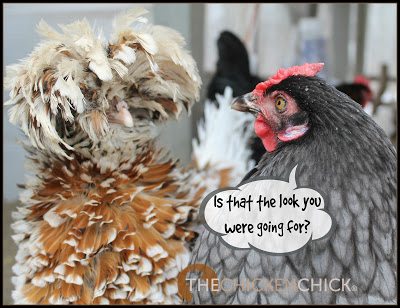
Ally McBeak, a Tolbunt frizzled Polish hen
PROBLEMS CREATED BY CRESTS
Slower Social Response & Injuries
As a result of feathers covering their eyes to varying degrees, crested chickens often behave differently and attract unwanted attention. Having limited vision impedes a crested bird’s ability to react quickly to everyday social interactions such as respecting the social structure in a flock. Every flock has a pecking order that dictates which chickens have priority access to food, water, roosts, nest boxes, dusting holes, etc. When a bird wishes to enforce the pecking order, she can usually do so by moving towards a lower-ranking flock member, which is generally enough of a clue to the underling to get out of the way. However, crested chickens that are unable to see other birds approaching to claim priority status may receive their message via a sharp peck on the head instead, which can result in feather damage and injuries.
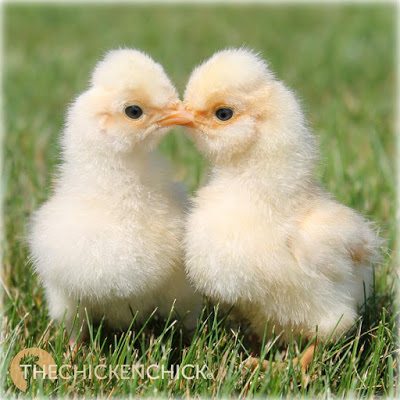
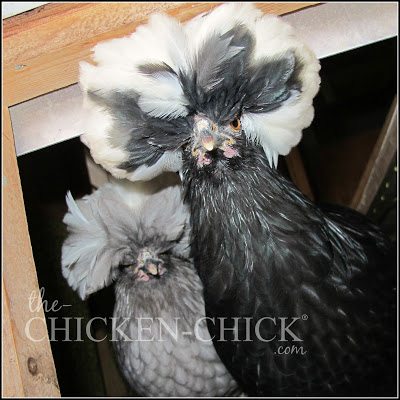
White Crested Blue Polish hen & White Crested Black Polish hen
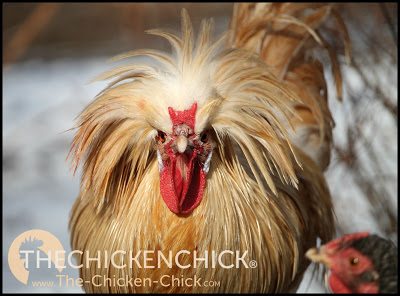
Gold laced Polish rooster
Public Relations Problems
Crested chickens are often accused of being less intelligent than other birds when the truth is: they simply can’t see well past their crest feathers. They can seem jumpy and may appear to over-react to certain interactions, but having obscured vision means are easily sneaked up on and surprised frequently. Imagine wearing a feather blindfold throughout your day and how that would impair your ability to find the front door, locate your lunch, negotiate past co-workers in the hallway, and to get out of harm’s way quickly. While this skittish behavior makes complete sense, it tends to relegate crested birds to the bottom of the pecking order and being bullied away from feeders, drinkers, dusting locations, and off roosts.
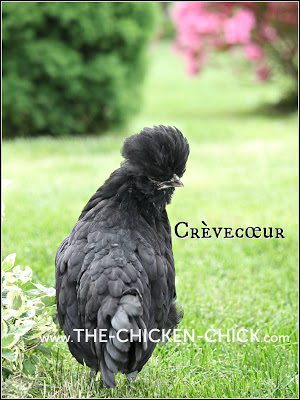
Crevecoeur hen
Sitting Ducks
Delays in response time due to impaired vision can also be life-threatening to a crested chicken.While other birds may see a predator approaching from a distance and scurry to safety, a crested bird may not see the predator in time to escape or may have difficulty seeing their way to a safe location quickly enough to escape harm.
B&B for Insects
Everyone loves a fluffy feather bed, including lice and mites, which tend to set up camp among the feathers of crested birds. Inspect crests for insects regularly during regular physical exams.
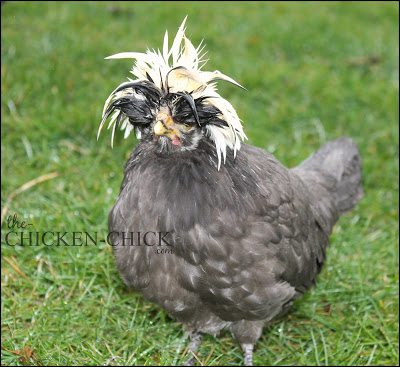
Rainy day Polish hen.
Fair Weather Feathers & Overexposure
Rain, snow and ice pose unique problems for crested birds. Rain causes feathers to hang and separate, revealing the pink skin underneath. Since chickens have such keen vision and inspect novelties with their beaks, they are drawn to investigate pin feathers, the skin and feather shafts, which frequently causes a feather-picking problem that can create a vicious cycle of baldness, head injuries, and feather regeneration, followed by more feather picking. Feathers that get wet in drinkers in freezing temperatures can form icicles, which are uncomfortable, can cause frostbite and draw unwanted attention from pecking beaks. Molting also exposes the skin on the head, drawing unwanted attention to the area.
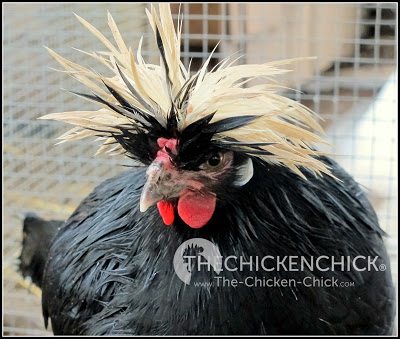
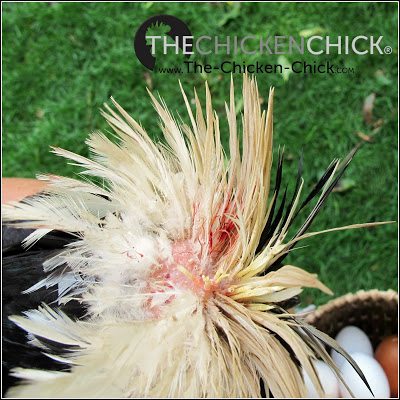
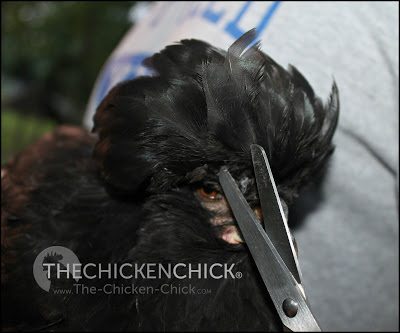
Rain and molting combined to set the stage for a pecking injury for Doc Brown. Crested birds with injuries must be removed from the flock and the injuries tended to until healed and not returned to the flock until their feathers have grown back to avoid a never-ending picking problem.
SOLUTIONS TO CREST PROBLEMS
If a crested chicken is not participating in a fair or poultry show, there is no need for their vision to remain obscured by feathers. Trim crest feathers around the eyes with sharp, blunt-tipped scissors. If you can’t see their eyes, your birds can’t see well enough, so don’t be shy about the amount trimmed. Emerging pin feathers (as shown below) draw unwanted attention to the scalp of crested breeds. Never trim emerging pin feathers. The base of the feather shaft contains a blood supply, which will bleed if nicked.
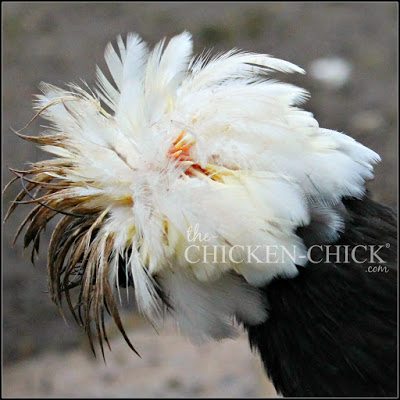
TIE-BACKS
Putting crest feathers in a ponytail on top of the head sometimes works to cover bald spots, hide pin feathers and to hide the scalp and some chicken keepers tie back their crested birds’ feathers with painter’s tape, but I haven’t found either of these to be especially helpful. The birds usually wriggle out of them in short order, creating another possible problem: ingestion of the ponytail holder or tape.
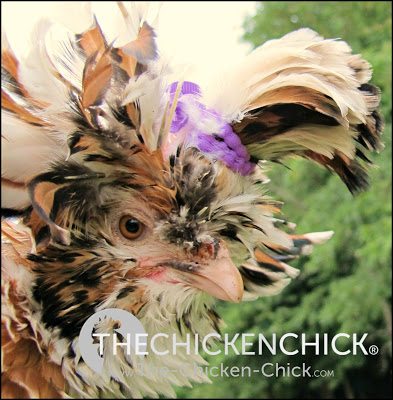
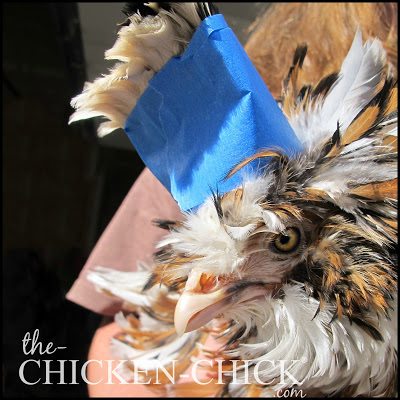
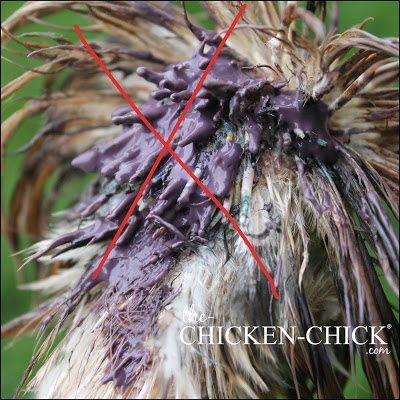
COLORED GOO IS NOT A SOLUTION!
JUST SAY “NO” TO COLORED “ANTI-PICK” PRODUCTS!
I do not recommend products that tint the skin and feathers blue or purple for several reasons. Coloring the wound does not conceal it from flockmates, in fact, the opposite is true! Chickens have superior color vision- better color vision than humans, and a novel colored goo or spray on another chicken’s body draws unwanted attention to the area, inviting exploration and additional picking. Further, the main ingredient of most cover-up products is alcohol, which burns like the surface of the sun on an open wound. Finally, colored dyes impede the ability to detect one of the first signs of infection, which is redness. Injured birds should be separated from flockmates and proper wound care administered until complete healing has occurred.
Re-introduction back into the flock without conflict will be extremely difficult if a bird is kept out of sight from flockmates for long periods of time. I recommend separating birds with crest injuries by housing them within a rabbit hutch or similar setup within the flock during the day to reduce these challenges. Once the injury has healed, re-integration is as simple as opening the “door” between the birds.
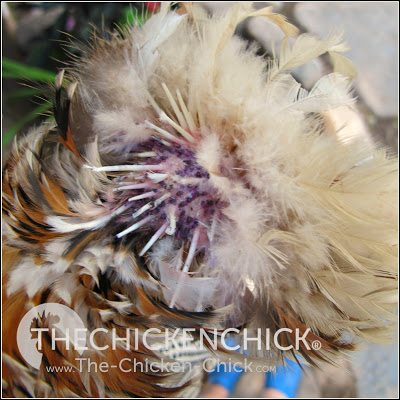
MORE CRESTED CHICKEN BREEDS
Kathy Shea Mormino
Affectionately known internationally as The Chicken Chick®, Kathy Shea Mormino shares a fun-loving, informative style to raising backyard chickens. …Read on


shop my SPONSORS
Sometimes being a fancy chicken isn’t all it’s cracked up to be. With showy poofs of feathers on their heads, crested chickens often encounter daily challenges other breeds do not. A chicken keeper that is aware of these potential challenges can make adjustments to improve their chicken’s quality of life and ensure flock harmony. Let’s take a look at some of those challenges and some simple accommodations that can help our feathered-hat-wearing friends.

Ally McBeak, a Tolbunt frizzled Polish hen
PROBLEMS CREATED BY CRESTS
Slower Social Response & Injuries
As a result of feathers covering their eyes to varying degrees, crested chickens often behave differently and attract unwanted attention. Having limited vision impedes a crested bird’s ability to react quickly to everyday social interactions such as respecting the social structure in a flock. Every flock has a pecking order that dictates which chickens have priority access to food, water, roosts, nest boxes, dusting holes, etc. When a bird wishes to enforce the pecking order, she can usually do so by moving towards a lower-ranking flock member, which is generally enough of a clue to the underling to get out of the way. However, crested chickens that are unable to see other birds approaching to claim priority status may receive their message via a sharp peck on the head instead, which can result in feather damage and injuries.


White Crested Blue Polish hen & White Crested Black Polish hen

Gold laced Polish rooster
Public Relations Problems
Crested chickens are often accused of being less intelligent than other birds when the truth is: they simply can’t see well past their crest feathers. They can seem jumpy and may appear to over-react to certain interactions, but having obscured vision means are easily sneaked up on and surprised frequently. Imagine wearing a feather blindfold throughout your day and how that would impair your ability to find the front door, locate your lunch, negotiate past co-workers in the hallway, and to get out of harm’s way quickly. While this skittish behavior makes complete sense, it tends to relegate crested birds to the bottom of the pecking order and being bullied away from feeders, drinkers, dusting locations, and off roosts.

Crevecoeur hen
Sitting Ducks
Delays in response time due to impaired vision can also be life-threatening to a crested chicken.While other birds may see a predator approaching from a distance and scurry to safety, a crested bird may not see the predator in time to escape or may have difficulty seeing their way to a safe location quickly enough to escape harm.
B&B for Insects
Everyone loves a fluffy feather bed, including lice and mites, which tend to set up camp among the feathers of crested birds. Inspect crests for insects regularly during regular physical exams.

Rainy day Polish hen.
Fair Weather Feathers & Overexposure
Rain, snow and ice pose unique problems for crested birds. Rain causes feathers to hang and separate, revealing the pink skin underneath. Since chickens have such keen vision and inspect novelties with their beaks, they are drawn to investigate pin feathers, the skin and feather shafts, which frequently causes a feather-picking problem that can create a vicious cycle of baldness, head injuries, and feather regeneration, followed by more feather picking. Feathers that get wet in drinkers in freezing temperatures can form icicles, which are uncomfortable, can cause frostbite and draw unwanted attention from pecking beaks. Molting also exposes the skin on the head, drawing unwanted attention to the area.



Rain and molting combined to set the stage for a pecking injury for Doc Brown. Crested birds with injuries must be removed from the flock and the injuries tended to until healed and not returned to the flock until their feathers have grown back to avoid a never-ending picking problem.
SOLUTIONS TO CREST PROBLEMS
If a crested chicken is not participating in a fair or poultry show, there is no need for their vision to remain obscured by feathers. Trim crest feathers around the eyes with sharp, blunt-tipped scissors. If you can’t see their eyes, your birds can’t see well enough, so don’t be shy about the amount trimmed. Emerging pin feathers (as shown below) draw unwanted attention to the scalp of crested breeds. Never trim emerging pin feathers. The base of the feather shaft contains a blood supply, which will bleed if nicked.

TIE-BACKS
Putting crest feathers in a ponytail on top of the head sometimes works to cover bald spots, hide pin feathers and to hide the scalp and some chicken keepers tie back their crested birds’ feathers with painter’s tape, but I haven’t found either of these to be especially helpful. The birds usually wriggle out of them in short order, creating another possible problem: ingestion of the ponytail holder or tape.



COLORED GOO IS NOT A SOLUTION!
JUST SAY “NO” TO COLORED “ANTI-PICK” PRODUCTS!
I do not recommend products that tint the skin and feathers blue or purple for several reasons. Coloring the wound does not conceal it from flockmates, in fact, the opposite is true! Chickens have superior color vision- better color vision than humans, and a novel colored goo or spray on another chicken’s body draws unwanted attention to the area, inviting exploration and additional picking. Further, the main ingredient of most cover-up products is alcohol, which burns like the surface of the sun on an open wound. Finally, colored dyes impede the ability to detect one of the first signs of infection, which is redness. Injured birds should be separated from flockmates and proper wound care administered until complete healing has occurred.
Re-introduction back into the flock without conflict will be extremely difficult if a bird is kept out of sight from flockmates for long periods of time. I recommend separating birds with crest injuries by housing them within a rabbit hutch or similar setup within the flock during the day to reduce these challenges. Once the injury has healed, re-integration is as simple as opening the “door” between the birds.




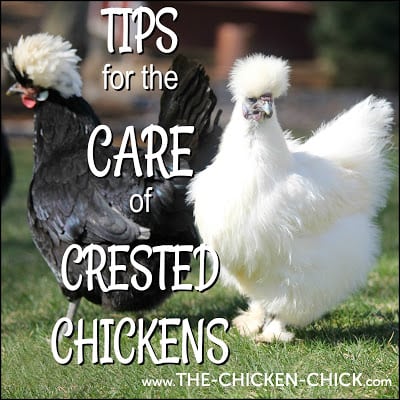
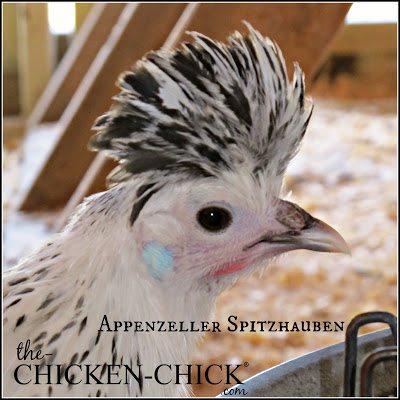
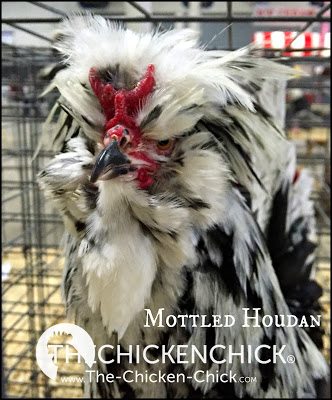
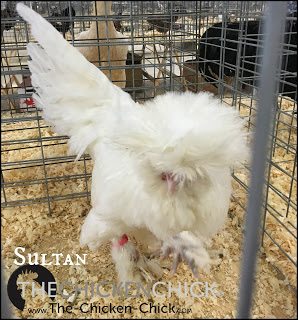
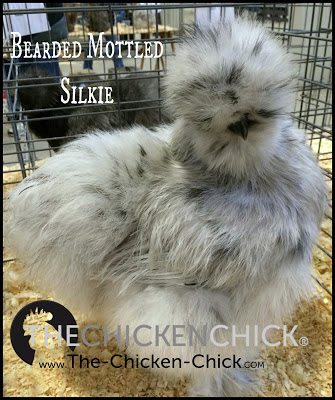
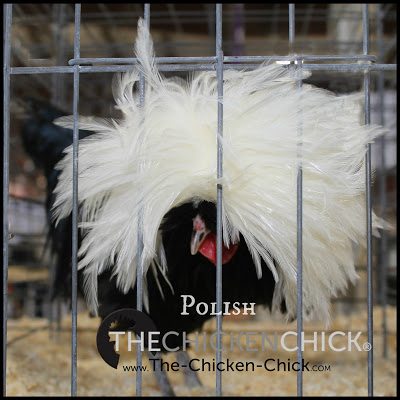
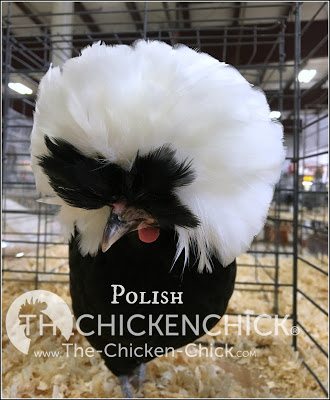
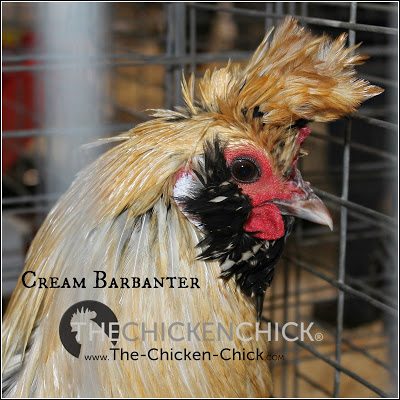
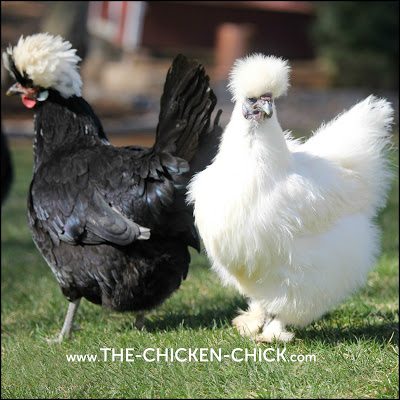
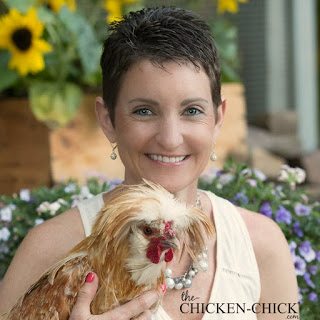

























As always, great information.
Love the crested breeds…we have a few different crested breeds. Love these sloggers!
I need new chicken poop shoes!! :)
I NEED new chicken poop shoes!! :)
I would love to win a pair